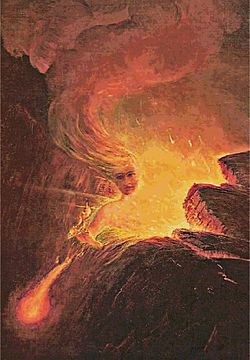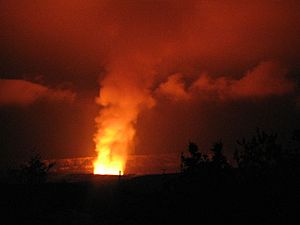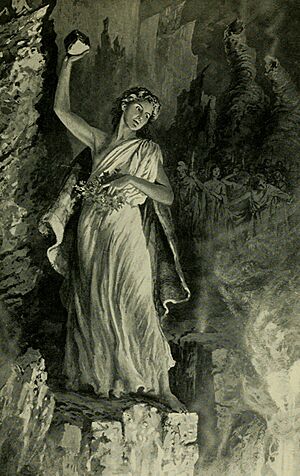Pele (deity) facts for kids
In Hawaiian religion, Pele (say "PEH-leh") is the powerful goddess of volcanoes and fire. She is also believed to be the creator of the Hawaiian Islands. People often call her "Madame Pele" or "Tūtū Pele" to show respect. She is a very famous goddess in Hawaiian mythology. Even today, she is an important figure from ancient Hawaii. Some of her special names include Pele-honua-mea ("Pele of the sacred land") and Ka wahine ʻai honua ("The earth-eating woman").
Many stories say that Pele was born from a female spirit named Haumea. Haumea is important because she came from Papa, the Earth Mother, and Wakea, the Sky Father. These two were descendants of the highest beings. Ancient Hawaiian chants call Pele "She who shapes the sacred land." The first stories about Pele that were written down were by William Ellis.
Contents
Legends of Pele, the Volcano Goddess
Kīlauea is an active volcano on the island of Hawaiʻi. Many Hawaiians believe a "family of fire gods" lives there. Pele is one of these sisters. She is thought to control Kīlauea and its lava flows.
Pele is known for her power, passion, and sometimes, her quick temper. She has many brothers and sisters. These include Kāne Milohai, Kamohoaliʻi, Nāmaka, and several sisters named Hiʻiaka. The most famous is Hiʻiakaikapoliopele. They are usually seen as children of Haumea. Pele's siblings are gods of wind, rain, fire, ocean waves, and clouds. Her home is believed to be the fire pit called Halemaʻumaʻu. This is at the top of Kīlauea, one of Earth's most active volcanoes. But her power covers all volcanic activity on the Big Island of Hawaiʻi.
Pele's Journey to Hawaiʻi
One legend says that Pele traveled by canoe from the island of Tahiti to Hawaiʻi. During her journey, she tried to create fires on different islands. But her sister, Nāmaka, was chasing her. Nāmaka wanted to stop Pele. In the end, the two sisters fought. Pele was killed in this battle. Her body was destroyed, but her spirit lives on in Halemaʻumaʻu on Kīlauea. People say, "Her body is the lava and steam that comes from the volcano." She can also change her form. She might appear as a white dog, an old woman, or a beautiful young woman.
Pele and Hula Dancing
Besides being the goddess of fire and volcanoes, Pele is also called the "goddess of the hula." She is very important in the history of hula dancing. This is because her sister Hiʻiaka is believed to be the first person to dance hula. Because Pele is so important, many hula dances and chants are dedicated to her and her family. Hula dances for Pele often show her strong personality and the movements of volcanoes.
Pele's Arrival Stories
In one story, Pele is the daughter of Kanehoalani and Haumea. She comes from a magical floating land called Kuaihelani. Her older sister, Nā-maka-o-Kahaʻi, a sea goddess, worried that Pele's fiery nature would harm their homeland. So, she drove Pele away. Pele traveled south in a canoe with her younger sister Hiʻiaka and her brothers. They arrived at the islets above Hawaiʻi. Pele used a special digging stick, Paʻoa, to find a new home. Some chants tell of Nāmakaokahaʻi chasing Pele. Nāmakaokahaʻi tore Pele apart. Pele's bones formed a hill, but her spirit escaped to the island of Hawaiʻi.
Another story says Pele came from a land "close to the clouds." Her parents were Kane-hoa-lani and Ka-hina-liʻi. From her husband, Wahieloa, she had a daughter, Laka, and a son, Menehune. Pele traveled to find her husband. The sea poured from her head over the land of Kanaloa. This flooding is called Kai a Kahinalii ("The sea of Ka-hina-liʻi"). This shows Pele's connection to the sea through her mother.
Pele and Poliʻahu, the Snow Goddess
Pele is known to be a rival of Poliʻahu, the Hawaiian goddess of snow. Poliʻahu and her sisters live on Mauna Kea. One myth says that Poliʻahu and her friends were at sled races. Pele came disguised as a beautiful stranger. But Pele became very jealous of Poliʻahu. She opened the caverns of Mauna Kea and threw fire towards Poliʻahu. The snow goddess fled to the mountain top. Poliʻahu finally grabbed her burning snow cloak and threw it over the mountain. Earthquakes shook the island as the snow cloak spread. It reached the fire and made the lava cold and hard. The lava rivers were pushed back to Mauna Loa and Kīlauea. Later battles also showed that the snow goddesses ruled the northern part of the island, and Pele ruled the southern part.
Pele, Hiʻiaka, and Lohiʻau
In one myth, Pele is sent away from her home in Tahiti. This is because her older sister, Namakaokahaʻi, thought Pele would burn everyone. Pele then traveled to find a new home with her brother Kamohoaliʻi. Her mother gave her an egg. This egg later hatched into a baby girl. Pele named her Hiʻiaka-i-ka-poli-o-pele (Hiʻiaka in the Bosom of Pele), or just Hiʻiaka. Hiʻiaka was Pele's favorite sister. Pele encouraged her to be friends with the people of Puna.
However, when Hiʻiaka became best friends with a girl named Hōpoe, Pele grew jealous. Pele saw Lohiʻau, a chief from Kauaʻi, in a dream. She sent Hiʻiaka to bring him to her within forty days. If not, Pele would punish them. When Hiʻiaka found Lohiʻau, he was dead. But she used the power of the sorcery goddess Uli to bring him back to life. While Hiʻiaka was on her journey, Pele became impatient. She sent a lava flow to Hōpoe's home before the forty days were over.
When Hiʻiaka returned to Hawaiʻi with Lohiʻau, she saw Hōpoe covered in stone. She knew Pele was responsible. Hiʻiaka, out of anger, hugged Lohiʻau in front of Pele. This made Pele even angrier. Pele then covered Lohiʻau with lava too. The sisters realized their anger had caused the death of the two people they cared about most. So, Pele brought Lohiʻau back to life and let him choose whom he wanted to be with. Lohiʻau chose Hiʻiaka. Pele, being apologetic, gave them both her blessing.
In another version, Pele heard drums and chanting from Kauaʻi while sleeping. She traveled there in her spirit form. She disguised herself as a beautiful young woman and met Lohiʻau. After three days together, Pele went back to Hawaiʻi. Lohiʻau died from a broken heart because he missed her so much.
Pele in Modern Times
Belief in Pele continued even after the old Hawaiian religion was officially stopped in 1819. In 1823, an English missionary named William Ellis visited the island. He ate wild berries near the Kīlauea volcano. These berries, from the ʻōhelo plant, are sacred to Pele. Traditionally, people would offer prayers to Pele before eating them. The active lava lake in the volcano made the natives fear Pele was not happy.
In December 1824, the High Chiefess Kapiʻolani went down into Halemaʻumaʻu. She said a Christian prayer instead of a traditional Hawaiian one to Pele. She survived, and missionaries often told this story to show their faith was stronger.
An urban legend says that Pele sometimes warns people about upcoming eruptions. She might appear as a beautiful young woman or an elderly woman with white hair. Sometimes she has a small white dog. She is always dressed in a red muumuu. Pele is said to walk along the roads near Kīlauea. But she will disappear if people stop to help her. This is like the "vanishing hitchhiker" stories. The person who saw her is then supposed to warn others. If they don't, they might have bad luck in the next eruption.
Another legend, called Pele's Curse, says that Pele will be angry with anyone who takes items from her island. Every year, many small natural items are sent back to the National Park Service by tourists. They hope to get Pele's forgiveness. It is believed Pele's Curse was created in the mid-1900s. It was meant to stop tourists from taking things from the park.
In 2003, the Volcano Art Center held a special contest for paintings of Pele. They wanted to replace an old painting from the early 1900s. This old painting showed the Hawaiian goddess looking like a blonde Caucasian woman. Many Native Hawaiians did not like this. Over 140 paintings were sent in. The winner was artist Arthur Johnsen of Puna. His painting shows the goddess in shades of red. She holds her digging staff, Pāʻoa, in her left hand. In her right hand, she holds an early form of her sister goddess Hiʻiaka. This painting is now at the Kīlauea Visitor Center.
Chants Honoring Pele
Hawaiian chants are special songs or poems. These chants are often performed at Halemaʻumaʻu, where Pele is said to live. They honor her power and presence.
|
Lapakū ka wahine a‘o Pele i Kahiki |
Pele is active in Tahiti |
|
Mai ka Lua a‘u i hele mai nei, mai Kīlauea, |
From the crater I’ve come, from Kīlauea, |
Pele in Geology
Several things related to volcanoes are named after Pele. These include Pele's hair, which are thin strands of volcanic glass. There are also Pele's tears, which are small, tear-shaped pieces of volcanic glass. Another is Limu o Pele (Pele's seaweed). A volcano on Jupiter's moon Io is also named Pele.
Myths about Pele sometimes describe real natural events from long ago. The stories of Pele's journey match the geological ages of the Hawaiian islands. In 2006, a scientist who studies volcanoes suggested that the battle between Pele and Hiʻiaka was inspired by volcanic events around the year 1500 AD.
See also
 In Spanish: Pele (mitología) para niños
In Spanish: Pele (mitología) para niños
- Painting of Pele
- Ti'iti'i, god of fire in Samoan mythology.
- Mahuika, goddess of fire in Māori mythology.
- Rūaumoko, god of earthquakes, volcanoes and seasons in Māori mythology.
- Vulcan, ancient Roman god of fire





